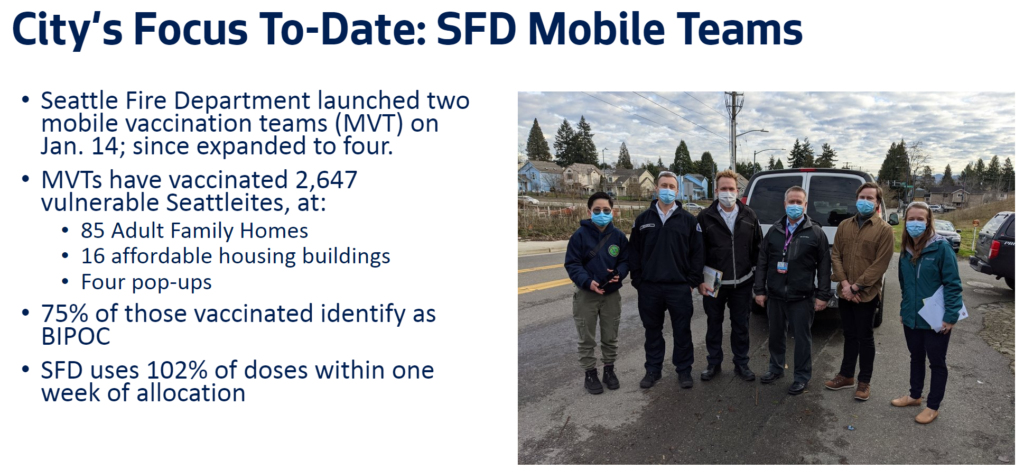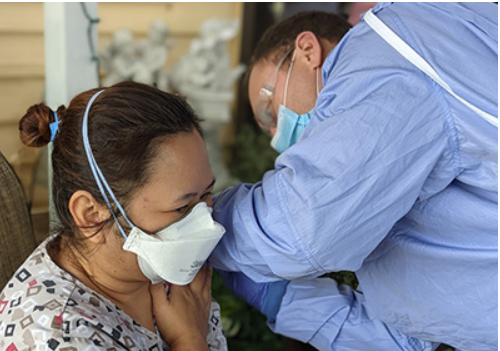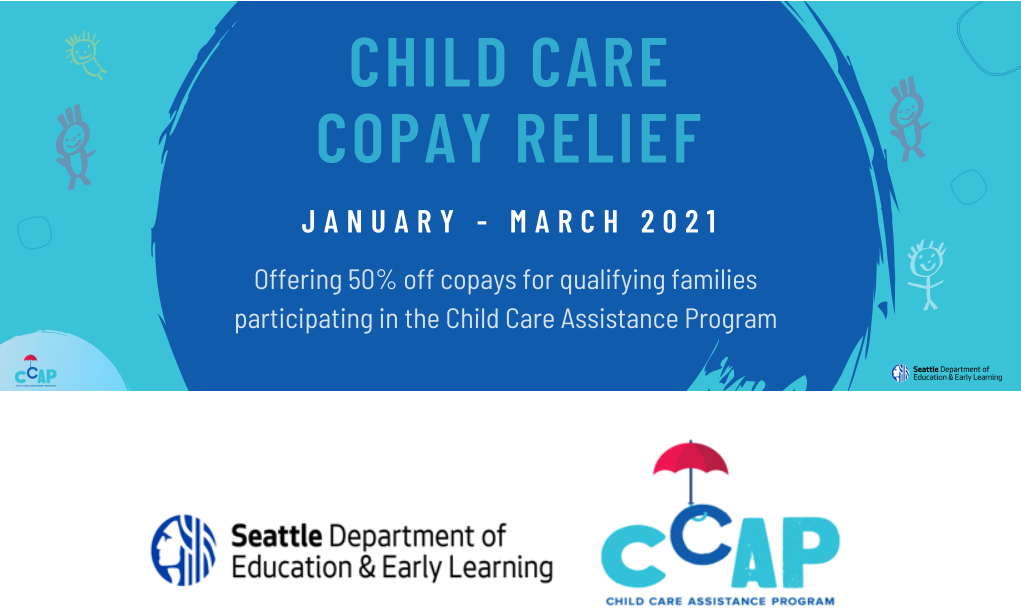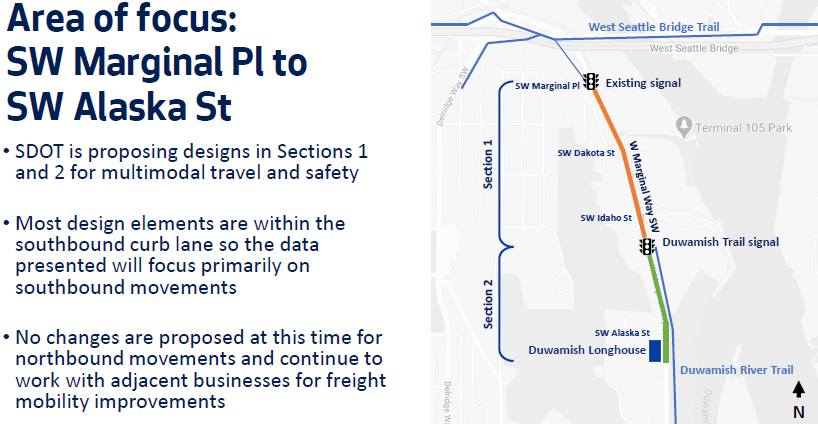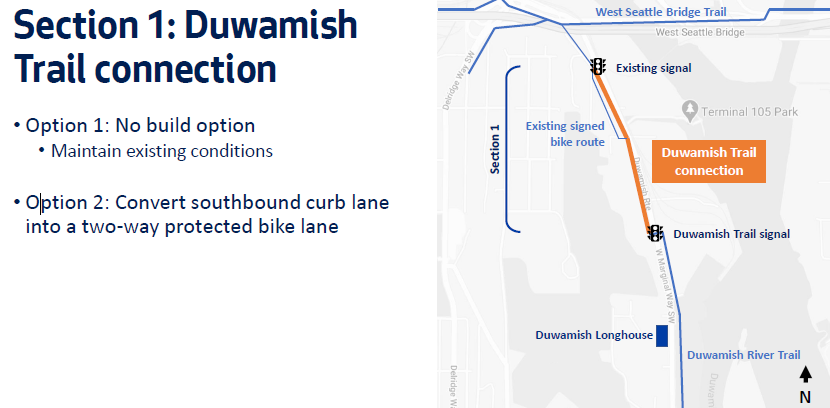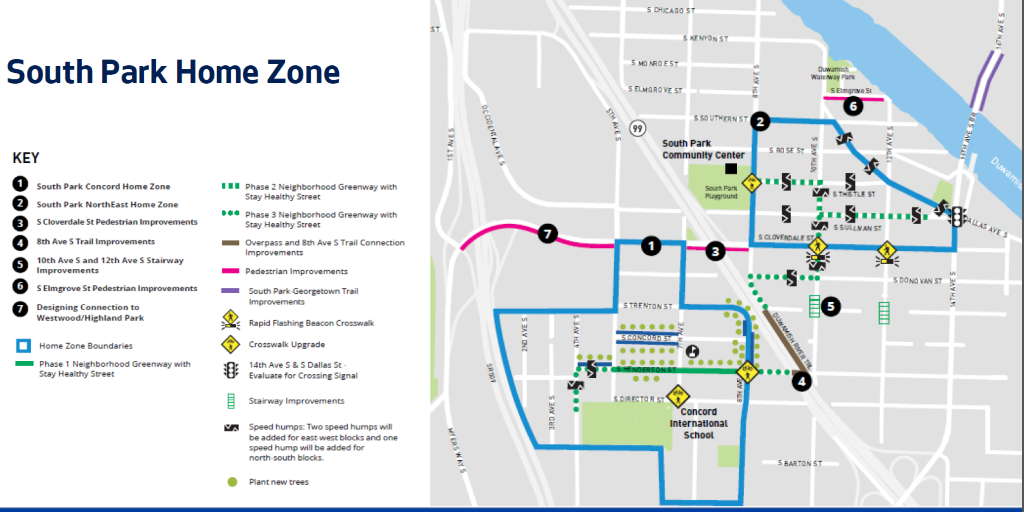COVID Vaccination Updates // Child Care Copay Relief // Don’t Be Fooled by a New Scam // Lower Bridge Use and Delay in Opening of T-5 // West Marginal Way SW Virtual Open House February 18 // South Park Home Zone // Building Code Updates
COVID-19 Vaccination Updates
I’ve heard from many District 1 residents over the past week concerned, frustrated, and confused about the difficulties of receiving a COVID vaccination. As many of you have discovered, vaccine providers are generally not offering appointments for the vaccine, because they do not have sufficient numbers of vaccines to distribute. The problem we are all experiencing is systemic – the federal government is neither producing nor able to purchase enough vaccine for everyone who is now eligible to receive it.
Right now, if you’re eligible to receive the vaccine, the best thing to do is add yourself to vaccine distribution waitlists (starting with your healthcare provider, if you have one), monitor the news for updated information about vaccine distribution, and keep up COVID precautions such as wearing masks and social distancing. Over the next weeks and months, vaccine supply will improve and more people will receive the vaccine.
Not enough vaccine to meet demand: Consider these numbers as an illustration of the problem: An estimated 470,000 King County residents are currently eligible to receive vaccination, but fewer than 200,000 first doses have been received throughout the County. Of the doses that King County has received, 99% have been administered according to Public Health data.
Washington state receives regular allocations of vaccine from the federal government. Of those, just over 25% are allocated to vaccine providers in King County. King County reports on its progress in administering those vaccines here. When vaccine providers learn they have a certain number of vaccine doses coming, they open up appointments for those doses, or contact eligible people on their waitlist. Because there is much more demand than supply, those appointments are quickly snapped up, and vaccine providers tend to shut down scheduling again until they learn more doses are coming. The federal government has announced plans to increase vaccine distribution to the states, meaning Washington may get increased shipments soon. But it will likely be some weeks before Washington state receives enough vaccine doses for everyone who is currently eligible.
West Seattle vaccination sites: Last week I wrote to you that the City of Seattle is planning for a mass vaccination site in West Seattle. The City’s Finance & Administrative Services department reports that they are procuring items needed to convert testing sites into mass vaccination sites. Tents, lighting and chairs have already been delivered to West Seattle in anticipation of a future vaccination site. Once the City receives sufficient vaccine supply, they will be able to move quickly and open up the West Seattle site within two days.
There are currently two vaccination sites accessible to those of us living on the West Seattle peninsula without requiring a bridge crossing, both operated by SeaMar Community Health Centers: one in White Center, 9650 15th Avenue SW, #100 98106; and the other in South Park, 8720 14th Avenue South 98108. Both are listed at the state Department of Health’s list of vaccination sites. I am hearing from many residents concerned about the unique mobility problems we face with the loss of the West Seattle Bridge, and am continuing to advocate for additional vaccine providers in West Seattle.
I appreciate the advocacy and leadership of Senior Center of West Seattle, whose Executive Director and board members have been actively reaching out to me and other elected officials to share the barriers that seniors are facing to accessing vaccinations, including: lack of a computer or internet access, difficulty reading web pages due to low vision, inability to make or receive texts, lack of an email address, and lack of nearby family or friends to help navigate these concerns. My office has connected the Senior Center with leaders at Public Health – Seattle & King County and the Mayor’s Office who are planning vaccination efforts to address these and other barriers.
City of Seattle vaccination plans: On Tuesday, February 9th at 9:30am, my Public Safety & Human Services committee will host a presentation on the City’s vaccination plans, including plans for a mass vaccination site in West Seattle. Presenters will include Director Hayes of Public Health – Seattle & King County, Chief Scoggins of Seattle Fire Department, and representatives from the Mayor’s Office. Sign up to receive the agenda, including a link to the presentation. You can tune in on Seattle Channel at 9:30am on Tuesday.
Language support: Getting information about the state’s vaccination rollout in languages other than English has been difficult. Public Health –Seattle & King County is now providing in-language vaccine information on its website:
Who can get the vaccine? The Washington State Department of Health (DOH) determines who is eligible for a COVID-19 vaccine. Right now the following groups can get vaccinated:
- Health care workers
- High-risk first responders
- Residents of long-term care facilities
- All people over 65 years-old
- All people over 50 years-old who live in a multigenerational household
Where can I get a vaccine? If you’re currently eligible, the FindYourPhaseWA.org will help you find out where you can get vaccinated in Seattle.
You can also get help over the phone from the Washington State COVID-19 Assistance Hotline: Dial 1 (800) 525-0127, then press #. The hotline is available from 6 a.m. to 10 p.m. Monday-Friday, and 8 a.m. to 6 p.m. Saturday and Sunday, and observed state holidays. Phone interpretation is available.
Looking for more information about vaccine distribution? Try some of these resources.
- Public Health – Seattle & King County’s vaccination website is an excellent resource, with lists of vaccine providers, and information about the County’s Kent and Auburn COVID-19 Vaccination Sites, which are currently serving adults 75 years and older from the hardest-hit areas of south King County.
- Decisions about vaccination plans are made by the Washington State Department of Health (DOH). Read the vaccination rollout plan here, and provide feedback here.
- The City of Seattle just launched a vaccine website and weekly vaccination newsletter: learn more and sign up here.
- King County hosts a COVID vaccine data dashboard, showing allocations of doses locally, as well as doses administered.
- Covid vaccines must be provided free of charge.
- Here’s a handy list of answers to Frequently Asked Questions about the COVID vaccine.
- Learn more about the safety of COVID vaccines in the US.
Preferential Access to Vaccine
Data shared by Public Health of Seattle & King County show that inequitable distribution of vaccine is occurring systemically in our community. Native Hawaiian and Pacific Islanders represent 2.7% of COVID-19 cases, but only .5% of vaccinations. Black/African-Americans make up 12% of King County’s COVID-19 cases, but only 3.5% of vaccinations.
After reading alarming reports last week about area hospitals providing priority access to vaccines to their wealthiest donors, on Friday I contacted Umair Shah, Secretary of Health, and Lacy Fehrenbach, Deputy Secretary for COVID-19 Response, at the Washington State Department of Health (DOH) to request corrective action:
As a Seattle City Councilmember, I was dismayed to read reports of local hospitals offering their top donors preferential access to precious and rare COVID-19 vaccine doses. I regularly hear from residents of my district in southwest Seattle who are currently eligible for vaccination and desperate to receive the vaccination, especially those with additional vulnerabilities who are all but housebound due to their fear of contracting coronavirus. I have been particularly concerned as my district is in south Seattle, and many of my constituents belong to BIPOC and vulnerable communities, experiencing the highest levels of COVID-19 impact and often unable to easily navigate online systems such as PhaseFinder to get up to date information about vaccine availability. The actions of leaders at Overlake and other hospitals amount to selling vaccines to the highest bidder, while many more vulnerable residents wait, and worry, and suffer.
I was glad to see Seattle Mayor Durkan speak out strongly against this practice, and I believe it is incumbent upon all officials right now to clearly state that this practice is unacceptable. So many people are desperate to receive the vaccine, and the rollout has been confusing for many. It’s understandable that people offered the vaccine may be tempted to take it. We must make it clear that “jumping the line” in this manner is unacceptable, so that vaccine is preserved for those at most risk…”
Would you put out a statement clearly stating that this practice is unacceptable, and that any providers who are administering vaccines must take steps to ensure vaccine is not prioritized based on wealth?
As Chair of the Seattle Council committee with oversight of local and regional public health efforts, I’m also interested in understanding the corrective action you may be planning or undertaking to 1) guard against this practice in the future and 2) admonish providers who have engaged in it.
Thank you for your leadership.
On Saturday, the Department of Health issued a statement calling this practice “egregiously inappropriate behavior,” and saying in part:
…to see such cavalier disregard for allocation strategy that prioritizes the most at-risk and disproportionately impacted populations is unacceptable.
Plainly said, this kind of practice is inequitable, wrong, and must stop immediately. Facilities or organizations found to engage in this practice risk not receiving additional shipments of vaccines.
On Monday, Department of Health sent a message to all approved vaccine providers across the state which said in part, “VIP scheduling, reserving doses for inequitable or exclusive access, and similar practices will not be tolerated. If we find out a provider is giving out vaccine inequitably or is doing behaviors listed above or similar, we may reduce or stop allocations to that provider.”
DOH also sent direct messages to any provider that they knew to have engaged in such a practice with the above message and additional notes that:
- We are aware their facility has been offering exclusive appointments for COVID-19 vaccine or reserving doses for privileged groups.
- VIP scheduling, reserving doses for inequitable or exclusive access, and similar practices will not be tolerated.
- If they continue to give out vaccine inequitably or engage in behaviors listed or similar, we may reduce or stop their vaccine allocations.
- Limiting public access to the vaccine continues barriers experienced regularly by vulnerable communities rather than working to overcome them. This not fair to the people of Washington.
Recipients of these direct messages were asked to verify that they understand this guidance, and DOH’s full vaccine allocation and prioritization guidance.
I appreciate DOH’s clear statement against the practice of prioritizing vaccines for the wealthiest, and their willingness to cut off supply for organizations engaging in it. It’s essential that we do everything we can to earn the trust of all Seattle residents right now during a confusing and frustrating vaccination rollout. Any institution that proves itself unworthy of that trust should not be allowed to distribute vaccine. We must ensure that our community’s most vulnerable are first in line, not last, to receive life saving vaccine.
Child Care Assistance Available
The Child Care Assistance Program (CCAP) helps families living within Seattle city limits who have with a parent working or attending school to pay for child care for children 1 month to 12 years of age. Find out if you’re eligible here. Start the screening process here.
Don’t Be Fooled By a New Scam
Be aware, scammers are at it again… If you receive a call threatening to shut off your electricity or water if you don’t make a payment today, just hang up the phone.
Seattle City Light and Seattle Public Utilities are not having a widespread problem processing payments, and the City will not turn off anyone’s utilities for failure to make payments during the current COVID health emergency.
Lower Bridge Use and Delay in Opening of T-5
Yesterday evening I heard that the opening date for Terminal 5 will be delayed. Today, I sent the following request to SDOT Director Zimbabwe regarding use of the lower (Spokane Street) bridge:
Director Zimbabwe,
I appreciate the work SDOT has been doing with the Lower Bridge Subcommittee regarding future access to the lower (Spokane Street) bridge. Thank you for expanding the committee membership to include health care representatives.
I further appreciate SDOT’s close monitoring of traffic counts by time of day, with the beginning of camera enforcement.
Yesterday evening I heard the news that construction and subsequent Phase 1 opening of Terminal 5 will be delayed. I appreciate that SDOT has been, understandably, reserving space for truck traffic in its calculations regarding future use of the lower bridge, given the previously projected start of additional truck traffic as soon as April.
SDOT has reported that the lower-bridge access “Current approach allows 450 user trips per day on top of freight, transit and emergency vehicles. This approach is based on a lot of assumptions: number of trucks, time of day that trips are distributed– includes both T5 projections and current truck volumes”
As District 1 Councilmember, I continue to receive regular requests for additional bridge access from residents, businesses, health care workers, and others.
Given this change in plans for T5, I am requesting that SDOT:
- Share the previous assumptions on number of user trips projected to be needed in April to accommodate T5 that will not be needed now;
- Calculate the user trips per day that could be newly added now that additional truck volume will not be anticipated in April; and
- Please consider ways to use this additional capacity to facilitate additional use of the lower bridge.
Thank you in advance for your consideration of my request and all that you do.
Best,
Lisa Herbold
District 1 Councilmember, Chair, Public Safety & Human Services Committee
West Marginal Way SW Virtual Open House February 18
SDOT will host a virtual open house on West Marginal Way SW on Thursday, February 18, from 6 to 7:30 p.m. Information will be available at SDOT’s new West Marginal webpage, which is under construction.
The project flyer notes the Duwamish Longhouse Crossing and signal. An interim signal is planned for 2021, along with a crosswalk. A permanent signal is planned for 2022. Funding for this project began in 2020 with a Council budget measure I sponsored. This project has received widespread support.
A proposal for a bike lane has received mixed reception, as noted below.
A presentation to the West Seattle Transportation Coalition shows additional information about the project area, from near the bridge to the Longhouse, noting no changes are proposed for northbound lanes, though SDOT will continue to work with businesses on freight mobility improvements:
SDOT has options for two different road sections. The first section includes either 1) make no changes, or 2) converting the southbound curb lane into a 2-way protected bike lane:
Here’s what option 2 would look like:

The proposal for a bike lane has been controversial, and resulted in pushback from businesses, and residents of the northern portion of the peninsula who now use West Marginal as a key arterial to leave the peninsula. The proposal had robust discussion at the West Seattle Bridge Community Task Force.
West Seattle Bike Connections, Duwamish Valley Safe Streets and the West Duwamish Greenbelt Trails Group have expressed support for the project; the Freight Advisory Committee has expressed concerns.
Many constituents have also contacted my office with concerns that travel times will be adversely affected at a time when congestion on this corridor is at an all-time high because this is a major detour route for the closed West Seattle Bridge. Vehicle volumes on West Marginal have been over 150% of February 2020 level, before the closure of the bridge. In addition, travel times have been longer during peak hours (SDOT’s December 11 update lists increases in a.m. and p.m. travel times on West Marginal from the 1st Avenue South Bridge to Harbor Avenue at between 24% and 48% for peak travel).
For the second section of roadway, SDOT is presenting three options:
The SDOT Director has authority over use of city streets, including lane configurations.
Here’s the decision making timeline SDOT foresees:
South Park Home Zone
In addition to Highland Park, South Park is the other District 1 neighborhood where SDOT is working with the community to implement a Home Zone to improve pedestrian safety, as one of the priority Reconnect West Seattle projects.
Here’s the project area, and current proposals that are being planned or considered (you can see a full-size image here)
Updates include potential traffic calming on Dallas Avenue South, and evaluating the feasibility of a traffic signal on Dallas at 14th, just south of the bridge.
Implementation of priority projects could begin in quarters 2 through 4 during 2021, with continued neighborhood collaboration on long-term improvements.
If you have questions or comments, you can reach SDOT at WestSeattleBridge@seattle.gov. The Reconnect West Seattle Home Zones website has additional information about work on the South Park, Highland Park and Georgetown Home Zones.
Building Code Updates to Limit Natural Gas Use
On Monday the Council adopted two bills to update the building code, in order to take steps toward implementation of recommendations of the Seattle Green New Deal.
As the Central Staff memo notes: “Consistent with Resolution 31895 that established a Green New Deal for Seattle in August 2019 and Executive Order 2020-01 (Advancing a Green New Deal for Seattle), the proposed 2018 Seattle Energy Code would add to the code’s intent section the goal of reducing carbon emissions to the existing goal of increasing energy efficiency. To help achieve these goals, the most significant changes from the 2015 Seattle Energy Code are new restrictions on the use of fossil fuels and electric resistance for space and water heating. The water heating restrictions are limited to multifamily and hotel uses, based on the rationale that they have more predictable hot water demand as compared to commercial uses. Both restrictions would have a delayed effective date of January 1, 2022, to allow for additional outreach, and, specific to water heating, provide time for products meeting the requirement to become more readily available.”
Here’s a link to a presentation, which notes space heating and water heating account for 88% of fossil fuel uses in buildings. This leaves smaller uses such as gas fire places and cooking for further technical changes in the future.
I appreciate the attention to implementing items included in the Green New Deal, which the Council passed in August 2018 . This is just one of the items, please see the link to the resolution which has an exhaustive list of the items the City is working to address.
I want to give a special thanks to former Councilmember O’Brien for spearheading this work at the Council and his sponsorship of the Green New Deal resolution that made this work possible. Additionally, Councilmember O’Brien sponsored a Council budget action requiring the Office of Economic Development for a consultant study to:
- Understand the potential impact to workers as the City acts to reduce reliance on fossil fuels;
- Analyze where job growth is anticipated in clean energy and related industries; and
- Identify strategies for supporting small businesses and their workers as the City transitions away from fossil fuels.
While the study was unfortunately delayed due to resources being shifted to manage work related to covid, we do expect it delivered later this year. Once this study is received the Council may consider a prohibition of natural gas in residential construction as well.
In the 2021 budget the Council funded positions to move forward work related to the Seattle Green New Deal. To facilitate this work, the Council added funding for a Green New Deal advisor position that will work with the Green New Deal Oversight Committee, created to advise the Council and Mayor on implementing the Green New Deal I look forward to their recommendations. In a related action, the Council also added a climate policy advisor, to oversee implementation of the Climate Action Plan and measure progress toward its goals.
Posted: February 8th, 2021 under Councilmember Herbold, COVID-19, Education, Public Health, Seattle Fire Department, Transportation
Tags: Bridge, Building Code, Child Care, COVID, COVID-19, Lower Bridge, South Park, Vaccinations, West Marginal Way SW, West Seattle, Zone


